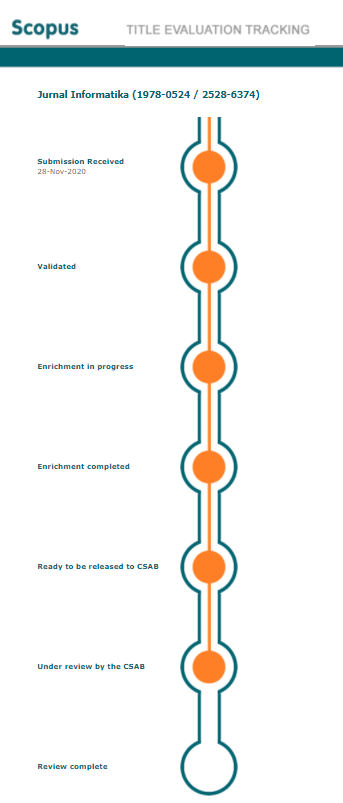Spatial and topology feature extraction on batik pattern recognition: a review
Abstract
Full Text:
PDFReferences
J. C. Torres et al., “Using a Cultural Heritage Information System for the documentation of the restoration process,” Proc. Digit. 2013 - Fed. 19th Int’l VSMM, 10th Eurographics GCH, 2nd UNESCO Mem. World Conf. Plus Spec. Sess. fromCAA, Arqueol. 2.0 al., vol. 2, pp. 249–256, 2013, doi: 10.1109/DIGITALHERITAGE.2013.6744761.
M. Muulab, “EKSTRAKSI FITUR MOTIF BATIK BERBASIS METODE STATISTIK TINGKAT TINGGI,” Semin. Nas. Inform., vol. 1, no. 1, Jul. 2015, Accessed: Dec. 07, 2020. [Online]. Available: http://jurnal.upnyk.ac.id/index.php/semnasif/article/view/1145.
J. Yu, “Texture image segmentation based on gaussian mixture models and gray level co-occurrence matrix,” Proc. - 3rd Int. Symp. Inf. Sci. Eng. ISISE 2010, pp. 149–152, 2010, doi: 10.1109/ISISE.2010.9.
M. S. Kankanhalli, B. M. Mehtre, and H. Yiung Huang, “Color and spatial feature for content-based image retrieval,” Pattern Recognit. Lett., vol. 20, no. 1, pp. 109–118, Jan. 1999, doi: 10.1016/S0167-8655(98)00100-7.
R. Dedy, D. Sartono, and T. H. Retnowati., “Study of the Value of Yogyakarta Batik Character and Its Implementation in Learning Batik in Vocational School,” pp. 8–13, Jun. 2019, doi: 10.2991/ICAAE-18.2019.2.
H. C V, “an Overview of Pattern Recognition,” Int. J. Res. Publ. Rev., no. April 2013, pp. 1883–1889, 2022, doi: 10.55248/gengpi.2022.3.7.49.
J. C. Bezdek, J. Keller, R. Krisnapuram, and N. R. Pal, “Fuzzy Models and Algorithms for Pattern Recognition and Image Processing,” vol. 4, 1999, doi: 10.1007/B106267.
N. A. Jalil, R. Sahak, and A. Saparon, “A comparison of iris localization techniques for pattern recognition analysis,” Proc. - 6th Asia Int. Conf. Math. Model. Comput. Simulation, AMS 2012, pp. 75–80, 2012, doi: 10.1109/AMS.2012.44.
L. C. Lulio, M. L. Tronco, and A. J. V. Porto, “Cognitive-merged statistical pattern recognition method for image processing in mobile robot navigation,” Proc. - 2012 Brazilian Robot. Symp. Lat. Am. Robot. Symp. SBR-LARS 2012, pp. 279–283, 2012, doi: 10.1109/SBR-LARS.2012.52.
A. H.N, M. D.H, and R. Bera, “A Fuzzy Reasoning Technique for Pattern Recognition,” Int. J. Comput. Appl., vol. 49, no. 12, pp. 19–23, 2012, doi: 10.5120/7679-0980.
H. Wei, “Research on a new intelligent industrial equipments MIS,” Proc. Int. Conf. Comput. Sci. Inf. Technol. ICCSIT 2008, pp. 775–778, 2008, doi: 10.1109/ICCSIT.2008.109.
X. Zeng and W. Jin, “Research of hand vein patterns recognition for biometric identification,” Proc. - 2012 Int. Conf. Biomed. Eng. Biotechnol. iCBEB 2012, pp. 884–887, 2012, doi: 10.1109/ICBEB.2012.338.
S. A. Begum and O. M. Devi, “Fuzzy Algorithms for Pattern Recognition in Medical Diagnosis,” Computer (Long. Beach. Calif)., no. 2005, pp. 1–12, 2011.
D. Chen, “Pattern recognition in software engineering trend adapting,” Grad. Theses, Diss. Probl. Reports, May 2001, doi: https://doi.org/10.33915/etd.1246.
V. S. Moertini and B. Sitohang, “Algorithms of Clustering and Classifying Batik Images Based on Color, Contrast and Motif,” J. Eng. Technol. Sci., vol. 37, no. 2, pp. 141–160, 2005, doi: 10.5614/ITBJ.ENG.SCI.2005.37.2.5.
E. Winarno, W. Hadikurniawati, A. Septiarini, and H. Hamdani, “Analysis of color features performance using support vector machine with multi-kernel for batik classification,” Int. J. Adv. Intell. Informatics, vol. 8, no. 2, pp. 151–164, 2022, doi: 10.26555/ijain.v8i2.821.
B. Arisandi, N. Suciati, and A. Y. Wijaya, “Pengenalan Motif Batik Menggunakan Rotated Wavelet Filterdan Neural Network,” JUTI J. Ilm. Teknol. Inf., vol. 9, no. 2, p. 15, 2011, doi: 10.12962/j24068535.v9i2.a34.
A. AhmadKasim, R. Wardoyo, and A. Harjoko, “Fuzzy C Means for Image Batik Clustering based on Spatial Features,” Int. J. Comput. Appl., vol. 117, no. 2, pp. 1–4, 2015, doi: 10.5120/20523-2853.
D. G. T. Meranggi, N. Yudistira, and Y. A. Sari, “Batik Classification Using Convolutional Neural Network with Data Improvements,” JOIV Int. J. Informatics Vis., vol. 6, no. 1, pp. 6–11, Mar. 2022, doi: 10.30630/JOIV.6.1.716.
J. Zhao, H. Lu, Y. Li, and J. Chen, “A kind of fuzzy decision tree based on the image emotion classification,” Proc. - 2012 Int. Conf. Comput. Meas. Control Sens. Network, C. 2012, pp. 167–170, 2012, doi: 10.1109/CMCSN.2012.43.
C. A. Astudillo and B. John Oommen, “Imposing tree-based topologies onto self organizing maps,” Inf. Sci. (Ny)., vol. 181, no. 18, pp. 3798–3815, Sep. 2011, doi: 10.1016/J.INS.2011.04.038.
N. Das et al., “A statistical–topological feature combination for recognition of handwritten numerals,” Appl. Soft Comput., vol. 12, no. 8, pp. 2486–2495, Aug. 2012, doi: 10.1016/J.ASOC.2012.03.039.
“Skeletal Graph Based Topological Feature Extraction of an Object.” https://www.yumpu.com/en/document/view/49180173/skeletal-graph-based-topological-feature-extraction-of-an-object (accessed Dec. 08, 2020).
X. Wang, X. Huang, and H. Fu, “A color-texture segmentation method to extract tree image in complex scene,” 2010 Int. Conf. Mach. Vis. Human-Machine Interface, MVHI 2010, pp. 621–625, 2010, doi: 10.1109/MVHI.2010.138.
N. Takahashi, M. Iwasaki, T. Kunieda, Y. Wakita, and N. Day, “Image retrieval using spatial intensity features,” Signal Process. Image Commun., vol. 16, no. 1–2, pp. 45–57, Sep. 2000, doi: 10.1016/S0923-5965(00)00029-1.
M. J. Fonseca, A. Ferreira, and J. A. Jorge, “Sketch-based retrieval of complex drawings using hierarchical topology and geometry,” Comput. Des., vol. 41, no. 12, pp. 1067–1081, Dec. 2009, doi: 10.1016/J.CAD.2009.09.004.
J. Hou and M. Pelillo, “A simple feature combination method based on dominant sets,” Pattern Recognit., vol. 46, no. 11, pp. 3129–3139, Nov. 2013, doi: 10.1016/J.PATCOG.2013.04.005.
DOI: http://dx.doi.org/10.26555/jifo.v16i1.a25415
Refbacks
- There are currently no refbacks.
Copyright (c) 2022 A A Kasim, M Bakri, A Hendra, A Septriani

This work is licensed under a Creative Commons Attribution-ShareAlike 4.0 International License.
____________________________________
JURNAL INFORMATIKA
ISSN :Â 1978-0524 (print) | 2528-6374 (online)

This work is licensed under a Creative Commons Attribution-ShareAlike 4.0 International License.






